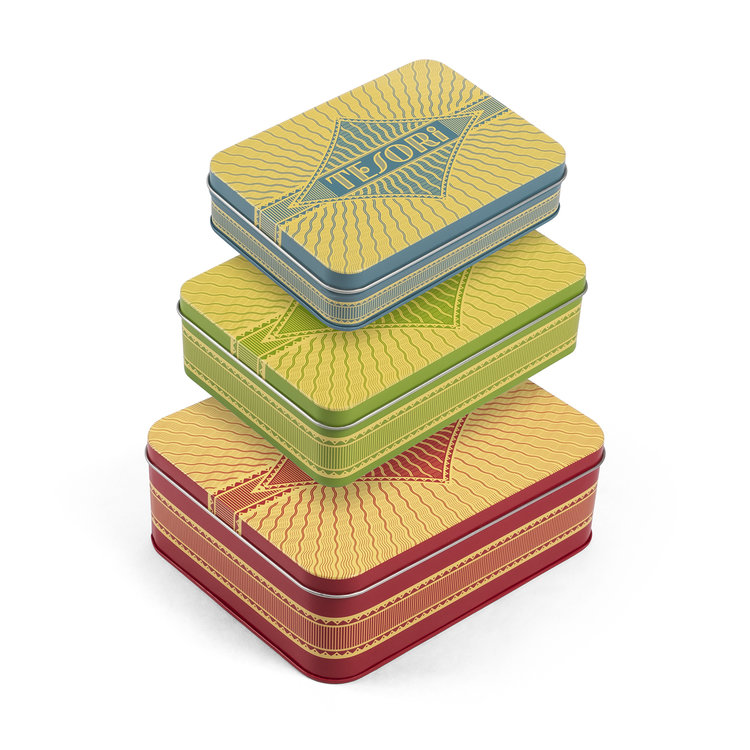Products |
Louise Fili: Brilliantly designed Italian pencils, gift cards, and more
By
Published: Nov 25, 2019
Category:
Gifts and Gadgets
When most people think of “style,” they think of fashion designers. I think of Louise Fili. You’ve seen her designs everywhere and every day: Williams-Sonoma, Sarabeth’s, Tiffany & Co., Paperless Post. For a decade, she designed the covers of Pantheon Books — that’s more than 2,000 book jackets. Of course she’s in the Art Directors Hall of Fame.
Fili’s specialty is Italy. Not the Italy of tourism. And not even the hidden Italy, the Italy accessible only to the very rich with chi-chi travel agents or low budget travelers willing to turn off the main roads. Fili explores a lost Italy, an Italy of the imagination. In a digital age, her work couldn’t be more analog. And more specific: Her inspiration is an era in Italian design that begins roughly in 1920 and ends with the neonization of signage in Italy around 1960. Louise Fili may live and work in New York, but her head and heart resides in Italy.
How did this happen?
When I was 16, I took my first trip to Italy with my parents, who were both born there; it was their first trip back. I remember taking a flight into Milan, and as we were leaving the airport, the first thing I saw was an ad for Baci Perugina — that was the only type on it. I was immediately fascinated by the billboard, which showed a couple in a passionate embrace. I knew that Baci meant “kisses,” but I didn’t know that it was advertising at all. It didn’t matter; I was smitten. It was a three-way epiphany for me, because that’s when I fell in love with type, food, and Italy all at once.
These days her trips to Italy are planned around the schedules of flea markets. On her best trips, she hits one a day. She returns with ideas that are never predictable.
This year, her offering is Tesori, which means “treasures” in Italian. It’s a kind of Marie Kondo treasure: 3 keepsake “nesting tins.” They come in red, green and blue. They stack. You can put one inside another. Or spread them out, eye-catching and entirely functional. To buy a set of Tesori from Amazon, click here.]
Veteran Butler readers will recognize other Fili creations. Perfetto Pencils are the go-to item. The sturdy pencil case is typical of Fili design: very clean, very precise, very bold design — very 1930s. Inside: twelve double-sided, two-color pencils. Why those colors? Why no eraser?
The two-color, double-sided pencils, commonly in red and blue, are ideal for teachers to correct homework. (“Errore lieve, segno rosso; errore grave, segno blu”: red for a minor infringement, blue for a serious offense.) When Princeton Architectural Press invited us to come up with a line of gift products, the two-tone pencils seemed perfect — thus the name. Steering clear of blue, our least favorite color, we opted for our signature red and black. No eraser, by the way. Who makes errori?
[To buy Perfetto pencils from Amazon, click here.]
Why stop at two colors? Fili followed up with Tutti Fruiti — Perfetto pencils in 6 delicious colors. [To buy Tutti Fruiti pencils from Amazon, click here].
But wait — there’s more. Quattro Parole Italiane: 12 note cards and envelopes. These twelve impeccably designed note cards feature graphically striking words: ciao (hello), auguri (greetings), grazie (thank you) and prego (with pleasure). What inspired her first paper product?
When I was in Milan researching a book on Italian art deco, I found myself one stifling afternoon in a magazzino — a warehouse — filled with printers’ proofs of labels and other ephemera from the 1920s. And I found a series of pasticceria papers, all created by hand. They were the most unusual and beautiful graphic work I’d seen in a long time. I brought them back to New York, where they ended up having a great influence on my design voice. Quattro Parole Italiane is a love letter to the anonymous designers who provided me with such unforgettable inspiration.
[To buy Quattro Parole Italiano from Amazon, click here.]
Finally, there’s a book: The Cognoscenti’s Guide to Florence: Shop and Eat like a Florentine. It’s a compact guide to just the kind of enterprises that are endangered everywhere: family- or locally owned and operated shops and eateries. In addition to stories about these businesses, there are eight walking tours, with restaurant suggestions. It’s the most informative, authoritative guide to Florence I’ve ever seen. To read it is to dream — and to plan. [To buy the book from Amazon, click here. For the Kindle edition, click here.]
When merchants speak of “one stop shopping,” they mean the mall. I mean Louise Fili.
BONUS VIDEO


